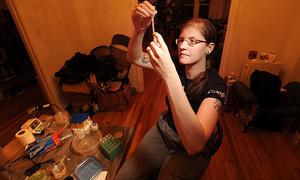BioterrorismGarage-lab bugs: spread of bioscience increases bioterrorism risks
There is a new fear about the possible source of a bioterror attack: scientific advances now enable amateur scientists to carry out once-exotic experiments, such as DNA cloning, which could be put to criminal use; as recently as a decade ago, the tools and techniques for such fiddling were confined to a handful of laboratories like those at leading research universities; today, do-it-yourself biology clubs have sprung up where part-timers share tips on how to build high-speed centrifuges, isolate genetic material, and the like

At work in her home gene lab // Source: guardian.co.uk
Rapid advances in bioscience are raising alarms among terrorism experts that amateur scientists will soon be able to gin up deadly pathogens for nefarious uses. Fears of bioterror have been on the rise since the 9/11 attacks, stoking tens of billions of dollars of government spending on defenses, and the White House and Congress continue to push for new measures.
The fear of a mass-casualty terrorist attack using bioweapons has always been tempered by a single fact: Of the scores of plots uncovered during the past decade, none has featured biological weapons. Indeed, many experts doubt terrorists even have the technical capability to acquire and weaponize deadly bugs.
The Wall Street Journal Keith Johnson writes that the new fear, though, is that scientific advances that enable amateur scientists to carry out once-exotic experiments, such as DNA cloning, could be put to criminal use. Many well-known figures are sounding the alarm over the revolution in biological science, which amounts to a proliferation of know-how — if not the actual pathogens (see “New book argues for change in biodefense policy,” 13 November 2009 HSNW).
“Certain areas of biotechnology are getting more accessible to people with malign intent,” said Jonathan Tucker, an expert on biological and chemical weapons at the James Martin Center for Nonproliferation Studies.
Geneticist Craig Venter said last month at the first meeting of a presidential commission on bioethics, “If students can order any [genetic sequences] online, somebody could try to make the Ebola virus.”
Venter is a pioneer in the field whose creation of a synthetic organism this spring helped push the debate about the risks and rewards of bioscience from scientific journals to the corridors of power in Washington. “We are limited more by our imagination now than any technological limitations,” Venter said.
Experts note that scientists have the ability to manipulate genetic material more quickly and more cheaply all the time. Just as Moore’s Law describes the accelerating pace of advances in computer science, advances in biology are becoming more potent and accessible every year (see “Gene synthesis companies establish measures to counter bioterrorism,” 20 November 2009 HSNW).
Johnson writes that as recently as a decade ago, the tools and techniques for such fiddling were confined to a handful of laboratories like those at leading research universities. Today, do-it-yourself biology clubs have sprung up where part-timers share tips on how to build high-speed centrifuges, isolate genetic material, and the like. The
